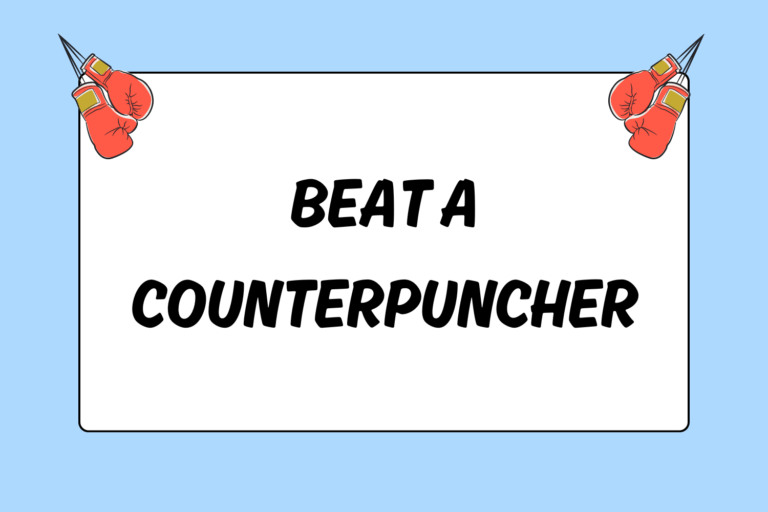In a bout between an orthodox boxer and a southpaw, the fighter with the more accurate and powerful cross punch usually leaves the ring victorious. When opposite-handed boxers match up, their body-positioning and stances generally make it easy for straight punches to land down the middle. As a southpaw, you should focus on improving the speed and accuracy of your left hand, since most of your fights will probably be against orthodox boxers. In addition, you’ll need to learn how to defend against the straight right hand of an orthodox opponent. Once you’re comfortable defending the straight right and can dodge the blow, you must learn how to counterattack. This guide analyzes the most effective ways for a southpaw boxer to counter an orthodox opponent’s straight right hand.
The Fundamentals of Countering
Counterpunching refers to the following sequence:
- Defending against an incoming punch.
- Quickly capitalizing on the temporary vulnerabilities of your opponent with your own punch or combination of punches.
Some fighters are known as “counterpunchers” because they prefer to have their opponents throw the first punch. Once the opponent throws a blow, the counterpuncher exploits the opponent’s weaknesses with quick, reactive punches. Counterpunchers are generally skilled defensively and have clear vision.
A southpaw matched up against an orthodox opponent should focus on circling to the right, avoiding the opponent’s straight right hand. Nonetheless, the opponent will sometimes be in position to throw his straight right hand. The rest of this guide focuses on defending against the straight right and responding with effective shots.
Jabbing Always Works
The jab is an essential skill for any style of boxer. Taller fighters score constant points by using their reach as they jab. Shorter fighters jab and feint jabs in order to close the distance. Brawlers use jabs to set up power shots. Pure boxers jab to set up combinations as they move in and out and side to side. Counterpunches, like all of the aforementioned boxers, rely on the jab as well.
At first glance, the jab may not seem like a valuable counter against an orthodox opponent with a strong right hand. However, it can be extremely effective if your movements are well-timed and precise. As your opponent throws his straight right hand, lean slightly to your left and throw the jab upward at your opponent’s head. In essence, you are actually slipping to your left and throwing your jab at the same time. Your slip allows you to avoid the incoming right hand, and the jab will land when placed precisely.
Slipping Left to Counter
Jabbing is the most basic counter, but other effective countering techniques include slipping. Most of these techniques work best when you include a pivot; although, pivoting may not be necessary if you find yourself at an ideal distance or angle to throw a punch.
Here’s an effective countering sequence that includes a pivot:
- Slip left to avoid his right hand.
- Pivot to your left.
- Counter punch.
The specific counterpunch you use depends on how you and your opponent are positioned after your slip and pivot. Often times, though, you’ll be able to respond with a straight left hand or short left hook. Keep the pressure on after you throw your initial counterpunch. Come at different angles, incorporating hooks and uppercuts to his body and head. The goal is to overwhelm your opponent as he tries to reposition himself and respond.
Hot Tip: Cross Him Back
Don’t be afraid to counter his cross with a cross of your own. If he throws a cross to your head, you often can drop down and respond with a cross to his body. His body will be exposed when he throws his right hand.
Catching & Blocking the Cross
You have two options when attempting to counter your opponents’ straight right with a block:
1. Catching the Punch
Like-handed boxers often catch each other’s jabs when they face off. When a southpaw faces an orthodox fighter, however, the cross can be caught instead of the jab. Follow these steps:
- Open your left glove in front of your face so that the palm faces your opponent.
- Shift your weight to your back leg in order to brace yourself for the impact.
- Allow the punch to make contact and prepare to counter.
The right hook and straight left are the two best counters off of this defensive move. If you throw a right hook, keep it short and throw it as soon as your opponent’s right hand makes contact with your left glove. If you throw a straight left, follow your opponent’s movement as he recoils back into his initial stance. As he brings his right hand back, your left hand can follow overtop.
2. Blocking With Your Arm
The final countering possibility involves blocking with you’re the back of your arm or elbow. Keep your left hand and elbow tight to your body and twist slightly to the right. As you twist, allow your opponent’s punch to land on the back of your left glove or forearm.
Once you rotate, you can respond by throwing a right hook or right uppercut. However, be wary of his left hook that may follow his straight right.
This technique is also useful when blocking and countering a straight right to your body. You need to bend your knees slightly, though, and take the punch on your left elbow.
Essential Angles
Boxing is a tactical game of angles. If you can circle and pivot effectively as a southpaw, you have a serious advantage over most orthodox fighters. Confuse your opponent by throwing punches at unfamiliar angles. Counterpunching depends on your ability to exploit openings on your opponent, and sound pivoting makes it much easier to find those openings.





